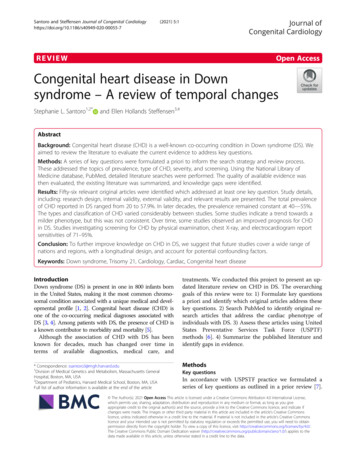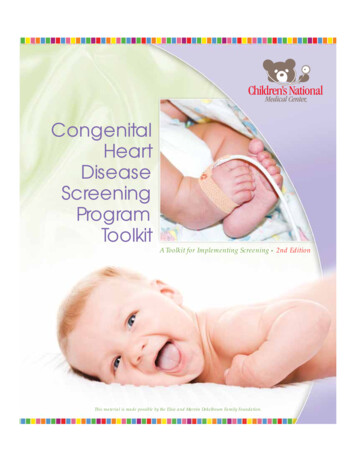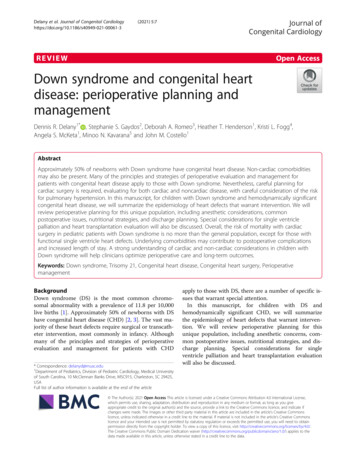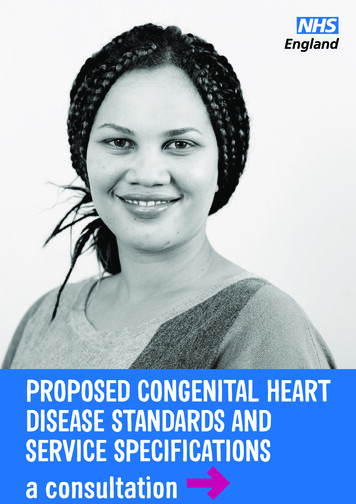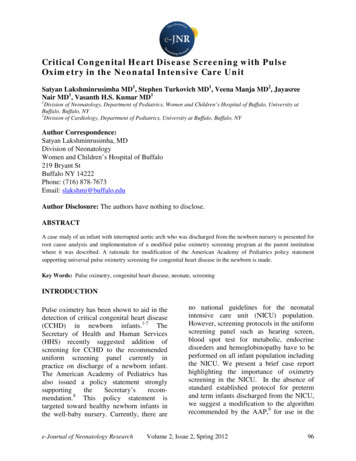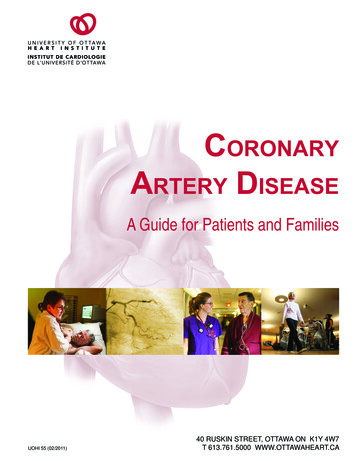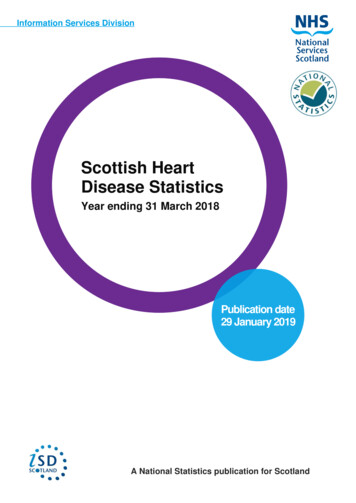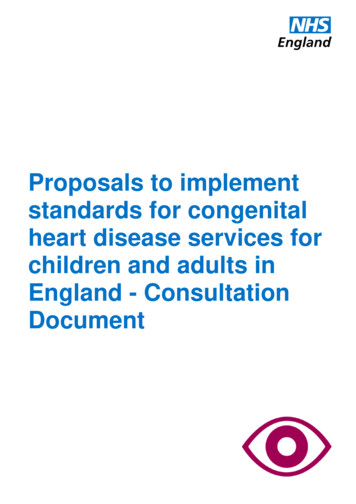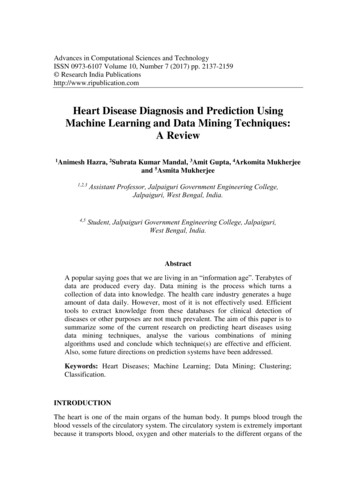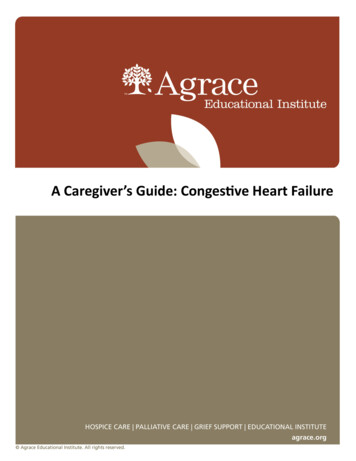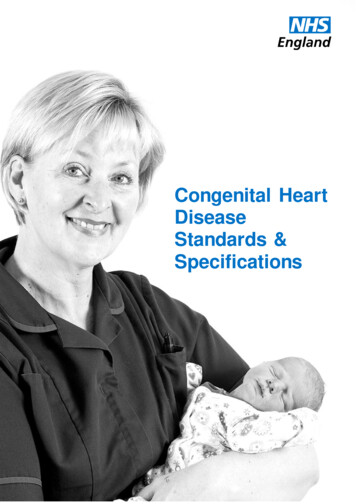
Transcription
Classification: OfficialCongenital HeartDiseaseStandards &Specifications1
Classification: OfficialNHS England INFORMATION READER BOXDirectorateMedicalNursingFinanceCommissioning OperationsTrans. & Corp. Ops.Publications Gateway Reference:Patients and InformationCommissioning Strategy05246Document PurposeOther (see Description)Document NameCHD standards and service specificationAuthorNHS EnglandPublication Date23 May 2016Target AudienceCCG Clinical Leaders, CCG Accountable Officers, Foundation TrustCEs , Medical Directors, Directors of Nursing, NHS England RegionalDirectors, NHS England Directors of Commissioning Operations, NHSTrust CEsAdditional CirculationList#VALUE!DescriptionThis document is part of a suite of documents setting out adult andpaediatric standards and service specifications for congenital heartdisease services in England.Cross ReferenceSuperseded Docs(if applicable)Action RequiredTiming / Deadlines(if applicable)Contact Details forfurther informationN/APaediatric cardiac-cardiology &surgery servcie specification 2013/14Implementation by providers of congenital heart disease servicesEffective from: 01/04/2016Anthony PrudhoeSenior Programme of Care Manager (Women and Children Specialised Services)NHS EnglandSkipton House, 80 London Road, LondonSE1 6LH020 7972 5972www.england.nhs.ukDocument StatusThis is a controlled document. Whilst this document may be printed, the electronic version posted onthe intranet is the controlled copy. Any printed copies of this document are not controlled. As acontrolled document, this document should not be saved onto local or network drives but shouldalways be accessed from the intranet.2
Classification: OfficialDocument Title: Congenital Heart Disease Standards &SpecificationsVersion number: V1.0First published: May 2016Prepared by: Michael Wilson/Nicola HumberstoneClassification: OfficialPromoting equality and addressing health inequalities are at the heart of NHSEngland’s values. Throughout the development of the policies and processes cited inthis document, we have: Given due regard to the need to eliminate discrimination, harassment andvictimisation, to advance equality of opportunity, and to foster good relationsbetween people who share a relevant protected characteristic (as cited underthe Equality Act 2010) and those who do not share it; and Given regard to the need to reduce inequalities between patients in access to,and outcomes from healthcare services and to ensure services are provided inan integrated way where this might reduce health inequalities.“This information can be made available in alternative formats, such as easy read orlarge print, and may be available in alternative languages, upon request. Pleasecontact 0300 311 22 33 or email england.contactus@nhs.net”3
Classification: OfficialContentsContents . 41Document summary . 52Adult Congenital Heart Disease (ACHD) Specification . 63Adult Congenital Heart Disease Standards: Level 1 – Specialist ACHD SurgicalCentres . 294Adult Congenital Heart Disease Standards: Level 2 – Specialist ACHD Centres 755Adult Congenital Heart Disease Standards: Level 3 – Local ACHD Centres . 1146Paediatric Cardiac Services Specification . 1427Paediatric Congenital Heart Disease Standards: Level 1 - Specialist Children’sSurgical Centres . 1728Paediatric Congenital Heart Disease Standards: Level 2 – Specialist Children’sCardiology Centres. 2249Paediatric Congenital Heart Disease Standards: Level 3 – Local Children’sCardiology Centres. 2664
Classification: Official1 Document summaryThe following document brings together a suite of documents setting out adult andpaediatric standards and service specifications for congenital heart disease servicesin England, agreed by the NHS England Board on 23 July 2015 and effective from 1April 2016.There are eight documents: Adult Congenital Heart Disease (ACHD) Specification Adult Congenital Heart Disease Standards: Level 1 – Specialist ACHDSurgical Centres Adult Congenital Heart Disease Standards: Level 2 – Specialist ACHDCentres Adult Congenital Heart Disease Standards: Level 3 – Local ACHD Centres Paediatric Congenital Heart Disease Specification Paediatric Congenital Heart Disease Standards: Level 1 – SpecialistChildren’s Surgical Centres Paediatric Congenital Heart Disease Standards: Level 2 – SpecialistChildren’s Cardiology Centres Paediatric Congenital Heart Disease Standards: Level 3 – Local Children’sCardiology CentresTo encompass the whole patient pathway each set of standards is subdivided intocategories A to M outlined below:A – The Network ApproachB – Staffing and skillsC – FacilitiesD – InterdependenciesE – Training and educationF – Organisation, governance and auditG – ResearchH – Communication with patientsI – TransitionJ – Pregnancy and contraceptionK – Fetal diagnosisL – Palliative care and bereavementM – Dental5
Classification: OfficialAdult Congenital Heart Disease (ACHD) Specification2 Adult Congenital Heart Disease (ACHD) SpecificationService SpecificationNo.E05/S/bServiceAdult Congenital Heart Disease (ACHD)Commissioner LeadAnthony PrudhoeProvider Leadn/aPeriod12 monthsDate of Review1. Population Needs1.1 National/local context and evidence baseThis specification covers all Adult Congenital Heart Disease (CHD) activity (surgeryand cardiology), taking place in the Specialist Adult CHD Surgical Centres (Level 1services) and Specialist ACHD Centres (Level 2 services), including activityundertaken by the Specialist Centres on an outreach basis where it is delivered aspart of a provider network.The Congenital Heart Disease Standards specify the requirements relating to thecare taking place in Level 3 services (Local ACHD Centres). This activity iscommissioned by Clinical Commissioning Groups and is therefore outside the scopeof this specification. Nevertheless Level 3 services are part of the Congenital HeartNetwork of Care and it is expected that Adult Level 1 and 2 services will work inpartnership with Level 3 providers to ensure all patient care is of a consistent, highquality.This specification excludes the following which are covered by separate servicespecifications, each of which can be located on the NHS England website www.england.nhs.uk: Inherited Cardiology Conditions (A09/s/c) Non Congenital Cardiac Surgery (A10/s/a) Services falling within the Complex Invasive Cardiology CRG (A09) Heart and Lung Transplantation Service (all ages) (A18/S/(HSS)/a)1.2 BackgroundAdult Congenital Heart Disease (ACHD) affects people aged 16 and over living with aheart defect acquired during fetal development. The demography of Congenital HeartDisease is changing. Largely as a consequence of successful cardiac surgery in6
Classification: OfficialAdult Congenital Heart Disease (ACHD) Specificationchildhood, there are increasing numbers of adults with congenital heart disease witha prevalence of more than 4 per 1000 adults. The number of patients with complexdisease is increasing with 10% of the adult congenital heart disease population nowfalling within the complex group. Congenital heart disease can be diagnosedantenatally, during childhood or may remain undetected until adult life. Most patientswith ACHD will require access to expert care and advice throughout their lives. Thepatient’s condition will require regular monitoring, supported by diagnosticinvestigations. The adult with ACHD may require a variety of interventions includingtranscatheter intervention, cardiac surgery, invasive electrophysiology and pacingprocedures, advanced heart failure management, palliative care and transplantation.The majority of ACHD patients will require on-going follow up and treatment in adultlife in a centre with expertise in adult congenital heart disease.Many ACHD patients will have had palliative surgery or catheter procedures inchildhood, others will have undergone definitive repair but may have significantresidual hemodynamic lesions and others may have had no specific treatment butrequire intervention in the future. The transition into ACHD is usually around 16 yearsof age. Transition to the ACHD service will normally be completed by age 18 andshould be managed by expert staff from both paediatric and adult backgrounds inaccordance with patient needs, to ensure a smooth transition to adult care.It is anticipated that there will also be a group of patients who will enter the service asadults having no previous exposure to cardiac services as children.The model of care is based on an overarching principle of the Congenital HeartNetwork, with agreed pathways and protocols for referral between the three levels.Adult Congenital Heart Services must partner with the Paediatric (and fetal) CardiacServices within the network to ensure that robust and co-ordinated communication,planning and co-operation exists.1.3 Current Service ProvisionStandards of care have been developed through the NHS England Congenital HeartDisease Review and form the basis of this service specification (Congenital HeartDisease Review Standards Group, 2015).The Standards of Care are based on the principle of a Network Model. Fetal,Paediatric and Adult services will work together in Congenital Heart Networks todeliver care through three “Levels” of provider as described in the Standards of Care.Each standard has a timescale for achievement ranging from those that must beachieved immediately to those which must be achieved within 5 years. Thetimescales are provided in the standards document.Network Care Levels: Level 1: Specialist ACHD or Children’s Surgical Centres Level 2: Specialist ACHD or Children’s Cardiology Centres Level 3: Local ACHD or Children’s Cardiology Centres7
Classification: OfficialAdult Congenital Heart Disease (ACHD) SpecificationIt is expected that Paediatric and Adult services will work in partnership within thenetwork to deliver high quality, safe and effective services as locally as possible,throughout the patient’s lifetime of care. The exact size and geography of theNetwork will depend on local need and circumstances and will be determined inpartnership with NHS England Commissioners. As much non-interventional treatmentas is safe to do so, should be delivered as close to home as possible. It is expectedthat Networks will collaborate together to ensure uniformity of care throughout thehealthcare system1.4 Evidence Base2011 BCCA/BCS/BCIS Guidelines on Intervention for ACHDDH – 2006 – A Commissioning Guide For Services for Young People and Grown Upswith Congenital Heart Disease (GUCH). This document has not been archived andthe following should be placed in the internet 20130107105354/http:/www.dh.gov.uk/prod consum dh/groups/dh digitalassets/@dh/@en/documents/digitalasset/dh 4134696.pdfNHS England – April 2013 – Review of Adult Congenital Heart Disease Services –Engagement on Proposed Model of Care and Draft Designation Standards – 11/4/13– 10/5/13Adult congenital heart disease interventions: recommendations from a Joint WorkingGroup of the British Congenital Cardiac Association, British CardiovascularIntervention Society, and the British Cardiovascular Society, Cardiology in the Young/ Volume 23 / Issue 01 / February 2013, pp 68-742. Outcomes2.1 NHS Outcomes Framework Domains & IndicatorsDomain 1Domain 2Domain 3Domain 4Domain 5Preventing people from dying prematurelyEnhancing quality of life for people withlong-term conditionsHelping people to recover from episodes ofill-health or following injuryEnsuring people have a positive experienceof careTreating and caring for people in safeenvironment and protecting them fromavoidable harm8
Classification: OfficialAdult Congenital Heart Disease (ACHD) SpecificationAn updated quality dashboard is now operational. Currently assessed outcomemeasures include the following:· Patient reported experience metrics;· Response to suspected/confirmed fetal diagnosis;· Last minute cancellations;· Unplanned re-interventions;· Complications;· Complaints; and· Hospital acquired infection ratesThe list of quality of care indicators included in the initial iteration of the dashboard isnot exhaustive and subject to ongoing revision.3. Scope3.1 Service Aims and ObjectivesService AimsThe Adult Congenital Heart Service aims to provide services in line with the agreedstandards of care and which operate within a Network Model encompassing thewhole lifetime of care. The service will manage known ACHD patients transitioningfrom paediatric services and identify/diagnose adults with congenital heart disease,who are, by definition, aged 16 years and over (recognising that the process oftransition to adult services may not be completed until the age of 18 years).The service for Adult Congenital Heart Disease aims to: Deliver best outcomes for patients, with lowest mortality, reduced disabilityand an improved opportunity for a better quality of life for survivors Consistently meet the standards of care (2016) and provide resilient 24/7 care Ensure that patients have co-ordinated care throughout the entire pathway,and feel supported and informed during their cardiac journey. Provide good patient experience, including information to patients and theirfamilies and consideration of access and support to families when they haveto be away from home Demonstrate clinical outcomes in line with national and international standardsfor adults with congenital heart diseaseService ObjectivesThe objectives of the service are to improve life expectancy and quality of life foradults with Congenital Heart Disease by: Development of Congenital Heart Networks to deliver a standardised model of9
Classification: OfficialAdult Congenital Heart Disease (ACHD) Specification care which meets national service standardsProviding high quality, timely and accurate diagnosisAgreeing treatment plans with patients (and their families)Undertaking safe and effective congenital heart surgery and catheterinterventionProviding appropriate counselling and psychological support to patients andtheir familiesEnsuring smooth and managed transition from paediatric to adult careSupporting patients to manage their ACHD condition independently in orderthat they can live a life less hindered by their conditionEnsuring effective communication between patients, families and serviceproviders that is sensitive to the physical, psychological and emotional needsof the patient and their familyProvide an individualised palliative care and bereavement serviceSystematically measure and act upon patient experience and satisfaction andcontribute to patient surveys where they exist (e.g. Somerville FoundationPatient Experience Questionnaire)3.2 Service description/care pathwayOverviewCongenital heart disease is a life-long condition and most patients will require accessto specialised care, including monitoring, provided by appropriately trained specialiststhroughout their lifetime. The model of care for adults with congenital heart diseaseis based on an overarching principle of a Congenital Heart Network. Working inpartnership with the Paediatric Congenital Heart services the network will adoptpolicies and guidelines agreed across the network relating to patient managementpathways within each of the centre’s specific care levels described below. TheCongenital Heart Networks will also be expected to link closely with related networkscovering areas such as heart and heart/lung transplantation.Networks must work together to develop and support national, regional and networkcollaborative arrangements that facilitate joint operating, mentorship and centre-tocentre referrals.Across an individual Network the units have been categorised into level of care asfollows:Network Care Levels: Level 1: Specialist ACHD Surgical Centres Level 2: Specialist ACHD Centres Level 3: Local ACHD CentresAcross the whole Congenital Heart Network there must be facilities in place to ensureeasy and convenient access for patients and their families/carers and facilities andwhere an inpatient stay is needed, support should include:10
Classification: OfficialAdult Congenital Heart Disease (ACHD) Specification Accommodation for partners/family members to stay (without charge)Access to refreshmentsFacilities suitable for the storage and preparation of simple meals; andAn on-site quiet room completely separate from general facilities (levels 2 & 3)Patients should be seen in an appropriate adult environment, ideally within adedicated ACHD ward/OPD space, and offered cultural and age-appropriate cardiacrehabilitation, taking into account any learning or physical disability.Patients must be supported to actively participate in decision making at every stageof their care.Patient PathwayAlthough the pathway will be individualised according to the individual patient need,patients will move between the three levels of service described above. Patients withmoderate or severe complexity may be cared for either in the Specialist ACHDCentre or the Specialist ACHD Surgical Centre and patients with simple congenitallesions may be cared for in their Local ACHD Centre. It is not anticipated thatpatients will follow a linear path through the three levels of care, but move betweenlevels as appropriate and determined by Network protocols and multidisciplinaryteam (MDT) planning. ACHD patients with complex lesions may be seen in localLevel 3 centres in collaboration with a specialist from Level 1 or 2 through jointclinics.Pathways must involve transition from paediatric congenital heart services and haveappropriate links with other adult specialties as defined in section 6.ReferralsPatients will be referred into the Adult Congenital Heart Service from several routesincluding: From Secondary and Tertiary care Consultants (elective or emergency) Formal transition from Paediatric Congenital Heart Services The patient’s GPUpon referral to the ACHD service, the service will: Provide a 24/7 telephone advice and assessment serviceProvide inpatient facilities to stabilise and monitor clinically appropriatepatientsCarry out a core ACHD MDT assessment of all referred patients with a newdiagnosis of significant congenital heart disease, within three months for nonurgent referralsAt point of transfer to the adult service all transition patients from paediatriccardiology will have a formal baseline assessment. This will include detaileddiscussion on prognosis, aetiology of condition and potential warning signswhich require urgent review.11
Classification: OfficialAdult Congenital Heart Disease (ACHD) SpecificationTransition from paediatric to adult CHD servicesTransition from paediatric to adults with congenital heart disease services (ACHD)The process of transitioning from paediatric to ACHD care must be initiated no laterthan the 12th birthday taking into account individual circumstances and special needs.Paediatric and Adult Congenital Heart Network centres will develop close workingrelationships to ensure smooth and effective transition of patients to appropriatefacilities, minimising loss of patients to follow up during the process. “Lost to followup” rates must be recorded and discussed by the network. The ACHD service will accept referrals of appropriate young people from thepaediatric cardiac network. All young people requiring ongoing congenital cardiac care/monitoring must beseen at least once by an ACHD cardiologist and ACHD Specialist Nurse in aspecialist MDT transfer clinic or equivalent and be supported by ageappropriate information and lifestyle advice. Particular needs of young people with learning disabilities and theirparents/carers must be considered, and reflected in an individual tailoredtransition plan. The Children’s Cardiac Transition Nurse will act as a liaison between youngpeople, their carers, the Children’s Cardiac Nurse Specialist, ACHD SpecialistNurse and wider multidisciplinary team to facilitate the transition process. The network must provide age-appropriate written and/or electronicinformation to patients and their families/carers, covering the full range ofsocial and health-related advice Each Congenital Heart Network must agree and provide formalisedoperational transition policy consistent with the congenital heart diseasestandards and the generic specification for transition produced by thepaediatric medicine CRG.Adult Congenital Heart Disease MDT The management of patients with significant congenital heart disease shouldbe discussed at combined MDT meetings at the Specialist ACHD SurgicalCentre. This includes all patients being considered for a complex catheterintervention, surgery or innovative procedures.Each MDT discussion must generate a signed record of the discussion andthe final outcome.When considering patients for complex catheter intervention or surgery(including out of hours and in emergencies) the minimum composition of theMDT is a Congenital Cardiologist, Congenital Surgeon and SpecialistIntensivist. Otherwise the composition of the MDT should be pathway driven,and adjusted according to the needs of different aspects of the service (forexample, assessment, post-operative care, clinic-pathological and auditmeetings).Staff from across the Congenital Heart Network should be encouraged toattend MDT meetings in person or by video/teleconferencing to participate inthe decision-making about their patient and for ongoing training and12
Classification: OfficialAdult Congenital Heart Disease (ACHD) Specification development.The attendance and activities of the MDT should be maintained in a register.Definition of Adult Congenital Heart Surgery and InterventionThe definitions of which surgical procedures should only be carried out by accreditedCongenital Cardiac Surgeons are attached in appendix 1.Initial CareThe appropriate Adult CHD Service will: establish a baseline against which disease progression and response totreatment can be measured;agree the need for any therapeutic intervention, either specific or supportive;offer treatment to all patients who might potentially benefit (eligibilityfor treatment to be determined as set out in relevant guidelines oras clinically indicated); andprovide patients and their families/carers with written and/or electronic materialrelating to the ACHD condition in an appropriate format.Ongoing careThe appropriate Adult CHD Service will hold/provide: regular patient reviews as per national guidelines or clinical practice withwritten and electronic records of current treatment and patient response;access to inpatient and critical care facilities where appropriate;access to other specialised services, e.g. PAH, transplantation, etc., asappropriate;appropriate access to pharmaceutical therapy;patient-centred services, sensitive to the individual’s physical, psychologicaland emotional needs and supported through the provision of patientappropriate information;access to appropriate shared care arrangements with other ACHD serviceproviders; andACHD Nurse Specialist telephone advice service for patients and theirfamilies/carers, healthcare professionals and non-healthcare and voluntarysector professionals.Dental CareThe dental treatment needs of ACHD patients must be identified and addressed priorto referral for any invasive procedure. Any outstanding treatment needs must beshared with the interventional/surgical team. Patients at risk of endocarditis musthave a tailored programme for specialised follow-up. The Network will have a clearreferral pathway for urgent dental assessments.13
Classification: OfficialAdult Congenital Heart Disease (ACHD) SpecificationPregnancy and ContraceptionAll female patients of childbearing age must be offered personalised pre-pregnancycounselling and contraceptive advice by an ACHD cardiologist and a nurse specialistwith expertise in pregnancy in congenital heart disease. They must have readyaccess to appropriate contraception, emergency contraception and termination ofpregnancy. The principle of planned future pregnancy, as opposed to unplanned anduntimely pregnancy, should be supported.A multidisciplinary cardiac obstetric service will be developed in conjunction witheach Level 1 and 2 unit.Male patients must have access to counselling and information about contraceptionand recurrence risk by a consultant ACHD cardiologist and nurse specialist withexpertise in congenital heart disease and, where appropriate, by a consultantgeneticist.Specific genetic counselling must be available for those with heritable conditions thathave a clear genetic basis. All patients must be offered access to a PractitionerPsychologist, as appropriate, throughout family planning and pregnancy and whenthere are difficulties with decision-making, coping or the patient and their partner areconcerned about attachment.Leaving the Pathway - Palliative or end-of-life careThe appropriate cardiac service will: provide symptom control where appropriate for patients with untreatable ordegenerative conditions;monitor patient response on a regular basis;use nationally approved palliative medicine pathways to plan care;agree a named lead doctor and nurse for any patient entering a palliative carepathway who will ensure the patient and their partner/family/carers aresupported up to and beyond death;produce a written, agreed, individual, end-of-life care plan;discuss the potential for tissues and organ donation;liaise actively with NHS and non-NHS professionals to ensure access toappropriate palliative or end-of-life services and make the patient and theirpartner/family/carers aware of these;ensure that when a death occurs in hospital, the processes that follow a deathincluding legal aspects are explained verbally, at the family’s pace and backedup with written information.maintain, where possible, continuity of care, the clinical team working closelywith the bereavement team.offer help with the registration of the death, transport of the body and signposting of funeral services.generate and publish evidence of effective palliative or end-of-life care forpatients / carers.14
Classification: OfficialAdult Congenital Heart Disease (ACHD) SpecificationGovernanceThe Network will have a Governance Framework in place which includesarrangements for: Regular continuous clinical audit and quality improvement.Regular network multidisciplinary team (MDT) meetings.Regular network meetings including reflection on: mortality, morbidity andadverse incidents.Regular audit days including discussion of adverse events and resultant actionplans.Regular network meetings of the wider clinical team (including network patientrepresentatives) at least every 6 months, for issues such as agreement ofprotocols, review of audit data and monitoring of performance.Patient registers/databaseAccurate coding and classification of rare disorders is necessary for determiningcorrect management, providing information on outcome and directing research. Thevalue of such registers to patients is discussed in the chapter ‘Empowering thoseaffected by rare conditions’ in the Department of Health’s 2012 document‘Consultation on the United Kingdom Plan for Rare Diseases’.The ACHD Centre will ensure that all patients requiring intervention are invited tohave their information collected and entered onto the appropriate national database.All ACHD Centres must: ensure there are written protocols covering communication between clinicians,and between clinicians and patients;participate in national programmes for audit and must submit data on allinterventions, surgery, electrophysiological procedures and endocarditis to thenational congenital database in the National Institute for CardiovascularOutcomes Research (NICOR); andco-operate in developing a national register of research trials and outcomes.Patient InformationPatients will be provided with high quality information throughout their care. Patientstransferring across or between networks will be accompanied by high qualityinformation including a health records summary and management plan.Patients/family/carers must be provided with accessible information about the serviceand the hospital including information about amenities in the local area, travelling,parking and public transport. Information must be made available in a wide range offormats and on more than one occasion. It must be clear, understandable, culturallysensitive, evidence-based, developmentally appropriate and take into accountspecial needs as appropriate. When given verbally, information must be precisely15
Classification: OfficialAdult Congenital Heart Disease (ACHD) Specificationdocumented. Information must be interpreted or transcribed as necessary.Information should include advice relevant to the patient’s condition: exercise and sports participation;sex, contraception and pregnancy;dental care and endocarditis prevention;smoking, alcohol and drugs;tattoos, piercings and intradermal procedures;careers;travel;welfare benefits;social services;community services; andinformation on the main signs and symptoms of possible complications ordeterioration and what steps to take.(not an exhaustive list)Annual reportsThe Congenital Heart Network will produce annual audit and
Heart and Lung Transplantation Service (all ages) (A18/S/(HSS)/a) 1.2 Background Adult Congenital Heart Disease (ACHD) affects people aged 16 and over living with a heart defect acquired during fetal development. The demography of Congenital Heart Disease is changing. Largely as a consequence of successful cardiac surgery in
